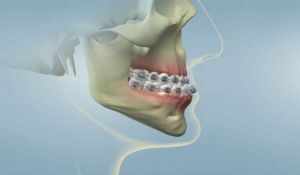 Mesial occlusion( mesioocclusion, progeny) is an anomaly in the structure of the maxillofacial part of the skull, which is characterized by a pronounced unnatural extension of the lower row of teeth in the ratio to the upper jaw, which is especially noticeable in tight compression.
Mesial occlusion( mesioocclusion, progeny) is an anomaly in the structure of the maxillofacial part of the skull, which is characterized by a pronounced unnatural extension of the lower row of teeth in the ratio to the upper jaw, which is especially noticeable in tight compression.
This kind of occlusion is also sometimes called medial or an anterial occlusion. Pathology is more characteristic of childhood, but it can also appear in adult patients.
Content
- Precipitating factors
- Types and forms anterialnogo bite
- Features symptoms and signs
- Functional disorders
- correction and treatment
- Retention period
- Risks
- Preventive
measures Aggravating factors
The most common reasons for the formation of meziookklyuzii are:
- heredity and defeat the body's chemicals,heavy metals during intrauterine development of the fetus;
- a neonatal trauma resulting from the passage of the birth canal and an anatomically short frenum of the tongue;
- Infantile diseases, such as rickets, as well as a violation in the succession of changing dairy teeth to permanent;
- absence of teeth due to their removal or trauma, constant mouth breathing in chronic ENT diseases;
- deviations in the behavior of the child - habits in the form of long thumbs sucking or pacifiers, lip-biting and so on;
- pathology and disease affecting the maxillofacial apparatus - trauma, tumor, the negative consequences of an incorrect previous treatment.
With timely access to a profile doctor, correct diagnosis and treatment to correct the defect is quite realistic.
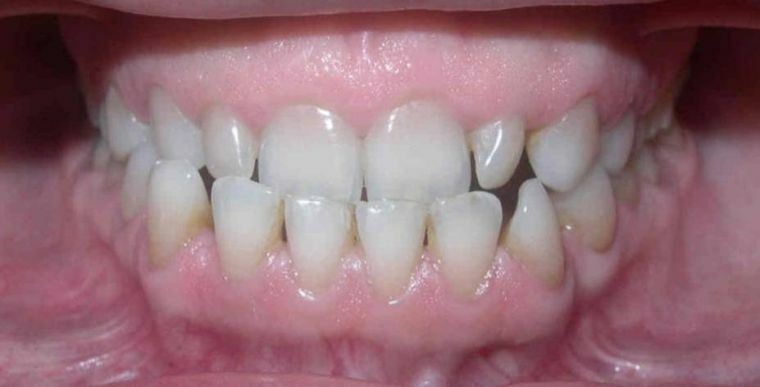
Types and forms of the anteroidal occlusion
The mesial occlusion can develop in three basic forms:
- The true form of the - with this variant of the pathology development the lower jaw protrudes strongly forward, blocking a number of upper teeth. Defect can be diagnosed visually - it manifests itself from the first days of a child's life, leading to cosmetic deficiencies in appearance, as well as problems with speech.
- False form of - incorrect bite is barely noticeable, and the anomaly is formed due to incomplete, atrophic formation of the upper or lower jaw bias forward. Most often provokes the development of this form of mesio-occlusion, the malfunctioning of the masticatory muscles, or the early replacement of milk teeth, inflammatory gum disease and bad habits.
- Combined form of - combines the signs and causes of the above-described true and false forms. It is considered quite difficult in the diagnosis and treatment.
In infancy during the shift in the patient's bite, doctors identify such forms of medial occlusion: 
- 1st form - mandibular teeth located centrally will overlap the upper ones, the jaws are normally developed;
- 2nd form - lower teeth slightly slip over the upper lip, with the central part of the upper, fixed jaw being sealed;
- The third form of is marked with a reduced size in the upper jaw, among other things there is excessive pressure of the tongue on the teeth, in particular, on their lower row, it is the heaviest in terms of diagnosis and treatment.
Features of the symptomatology and signs
The mesial type of occlusion is defined in both children and adults in characteristic, inherent only to him, obvious signs:
- the upper row of teeth will overlap the lower, with the apparent, accelerated growth of the upper jaw and the lag in the growth of the lower one;
- the anatomical structure and an arrangement in a head of a jaw joint is broken, due to what the chin will be protruded forward, thus the lower lip is protruded, the upper one will be more stretched;
- nose for this type of bite - stretched, and nasolabial folds are clearly expressed, the lower part of the face will be excessively shortened.
All these signs, or a combination of several of them, indicate the development of the patient's mesial occlusion.
Functional disorders
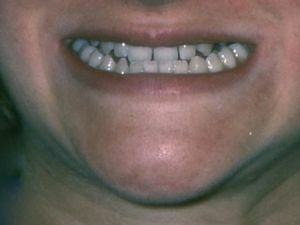 Violations in the physiological-anatomical structure of the occlusion lead to many changes in the structure and operation of the maxillofacial apparatus. Doctors in this list include a restriction in the normal, natural movement of the jaw joints - this is the most frequent of all disorders in diagnosing the medial occlusion.
Violations in the physiological-anatomical structure of the occlusion lead to many changes in the structure and operation of the maxillofacial apparatus. Doctors in this list include a restriction in the normal, natural movement of the jaw joints - this is the most frequent of all disorders in diagnosing the medial occlusion.
Patients also have augmented tongue - this deviation develops because of accelerated, excessive growth of not the upper, namely, the lower jaw. As a consequence, the quality of biting, as well as the subsequent chewing and digestion of food, sometimes causes a malfunction in the digestive tract, the development of gastritis and ulcers.
Along with the described problems, the facial muscle group is often underdeveloped in patients, which provokes speech defects. Due to the uneven food load, the periodontitis wears out quickly, which leads to deformation of the jaw and loss of teeth. And this, in turn, complicates the issue of the subsequent prosthetics and restoration of the dentition.
Correction and treatment of
Correction of mesial occlusion is a long process, depending not only on the underlying cause that triggered it, but also on the patient's age.
So, if we talk about the treatment of mesial occlusion in children and adolescents, then most often doctors install various bracket systems.
This treatment is complemented by a special exercise course for the facial muscle group. If the results of correction by brackets are insignificant, then operative intervention is applied, for example, undercutting of the shortened bridle of the tongue.
Along with this, in the process of correction of occlusion in children, doctors can use and vestibular plates - they help to wean the child of all bad habits, such as sucking a finger or nipples, biting lips and so on.
Treatment of mesio-occlusion in adults is more difficult and can take 3-4 years. Most often, doctors use one of such methods:
- orthognathic surgical intervention and various plastic corrections - the position of the lower jaw varies, its size and profile;
- use of orthodontic constructions - braces, kapy and other equipment;
- special removal of one or more teeth for correcting the jaw and its size.
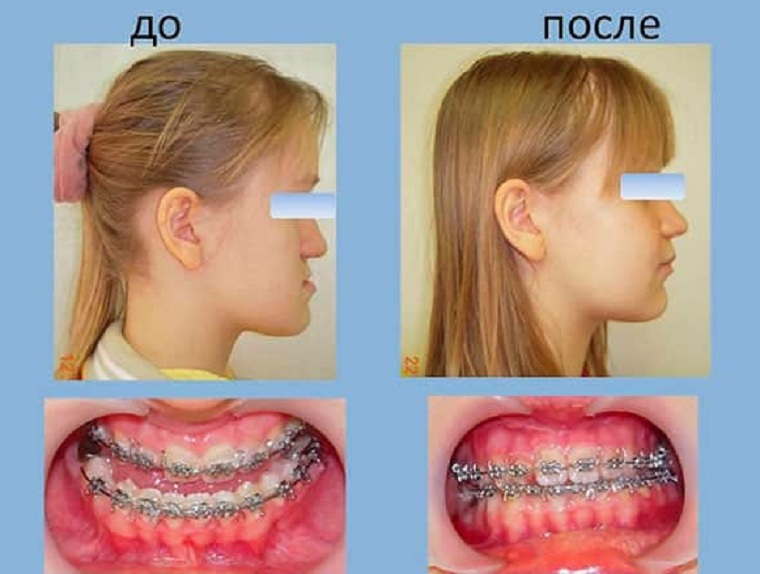
Correction of mesial occlusion in uncomplicated form is possible with braces, in severe cases,
can not be avoided. In each individual case, the method and method of bite correction depends on the situation, degree of disability and age of the patient.
Retardation period
After bite correction, a certain time for retention is required - fixing the result.
In order to preserve the results and prevent the teeth from parting again, doctors often practice the use of a non-removable retainer that is fixed to the back wall of the dentition.
Although the achieved results of treatment can be fixed using a removable type of cap. After the correct occlusion is formed, the doctor prescribes a course of exercises for the facial muscles.
The results of treatment for patients diagnosed with mesial bite can be assessed by examining the photo and video of the girl before and after the occlusion correction operation:
Before operation:
A year later. ..
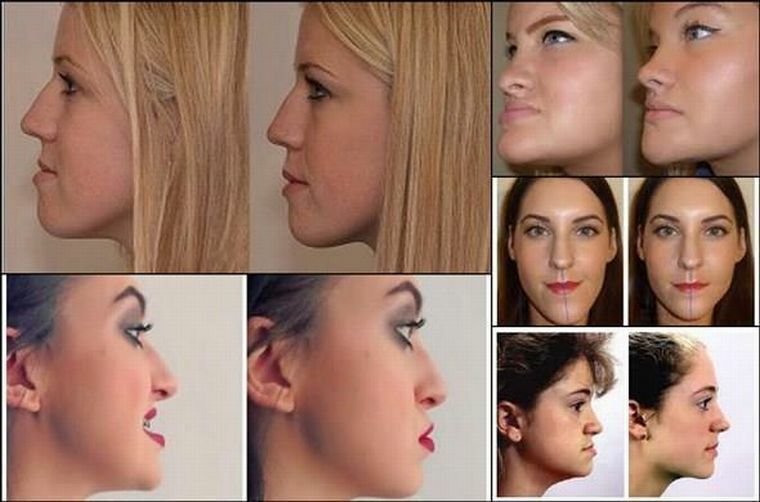
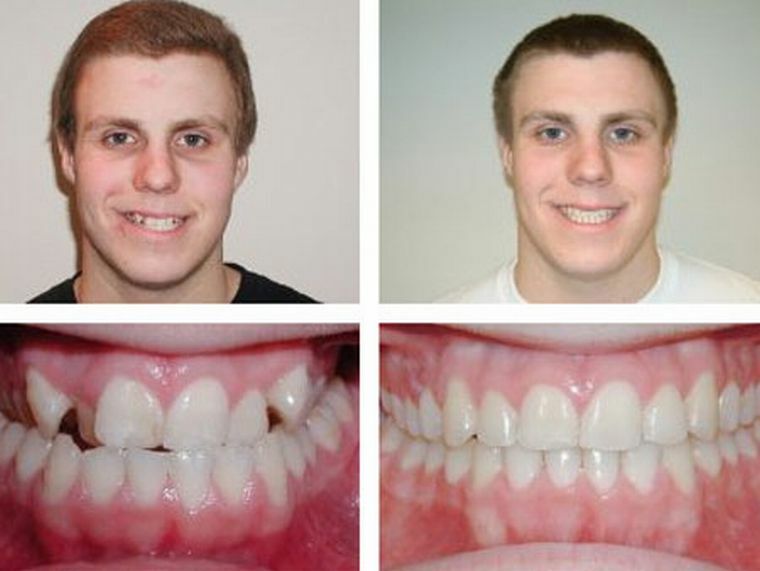
Possible risks
In the absence of attention to one's own health, if not timely to correct the prognosis, it cancause the following health problems:
- is fast and premature, not in age, tooth erasure and its subsequent destruction;
- because of poor-quality chewing food is a failure in the work of the gastrointestinal tract, develop problems with swallowing food and the subsequent irritation of rough food of the stomach and esophagus;
- attacks of ringing in the ears and migraines;
- spasms of the facial muscles and problems with the joints of both the upper and lower jaws.
Preventive measures
As medical statistics show, the medial occlusion is not always due to genetics in the reasons for its occurrence.
To prevent and prevent the development of occlusion abnormalities, doctors recommend the following:
- timely treat all diseases affecting the maxillofacial apparatus;
- regular visit to the dentist's office during the period of the child's milk teeth changing to permanent;
- braving a child from such a bad habit as sucking a finger is also worth the sooner, the better, wean it from the nipple, do not prop his chin with his fist - all this does not have the best effect on the formation of the bite;
- should monitor the position of the child's body during sleep, seat at the table, and timely prevention of problems with the spine and the formation of proper posture is also necessary.
Mesial bite is a serious orthodontic defect, but with timely access to specialized specialists, it is amenable to correction.
